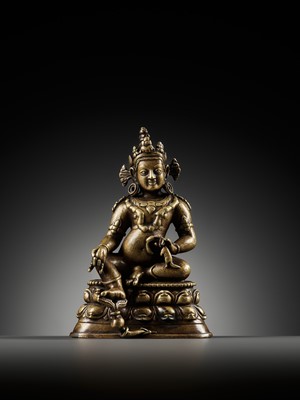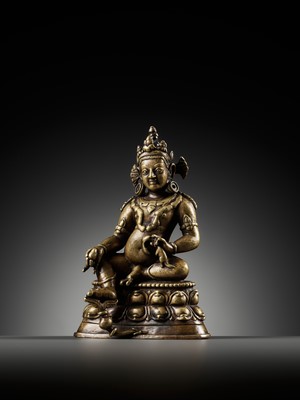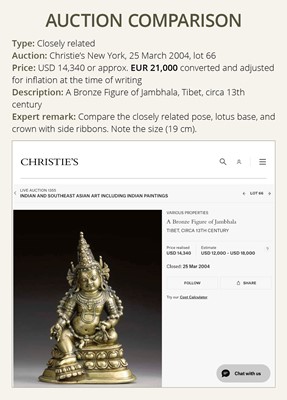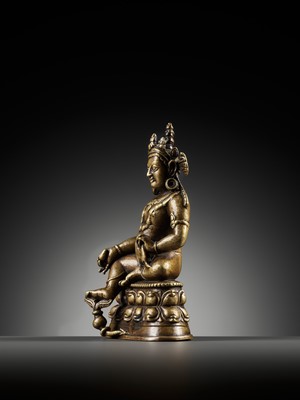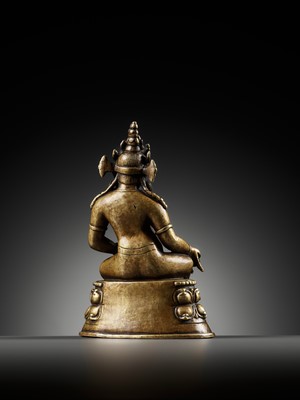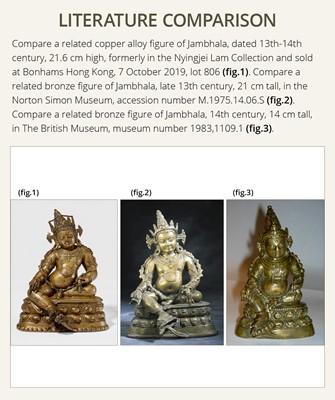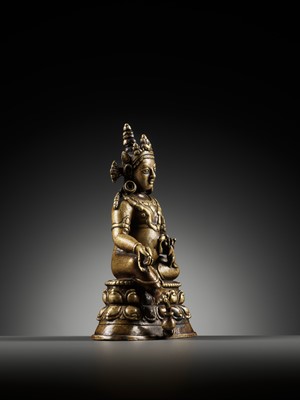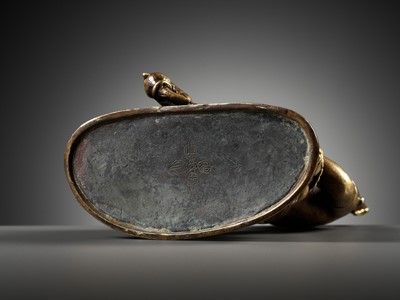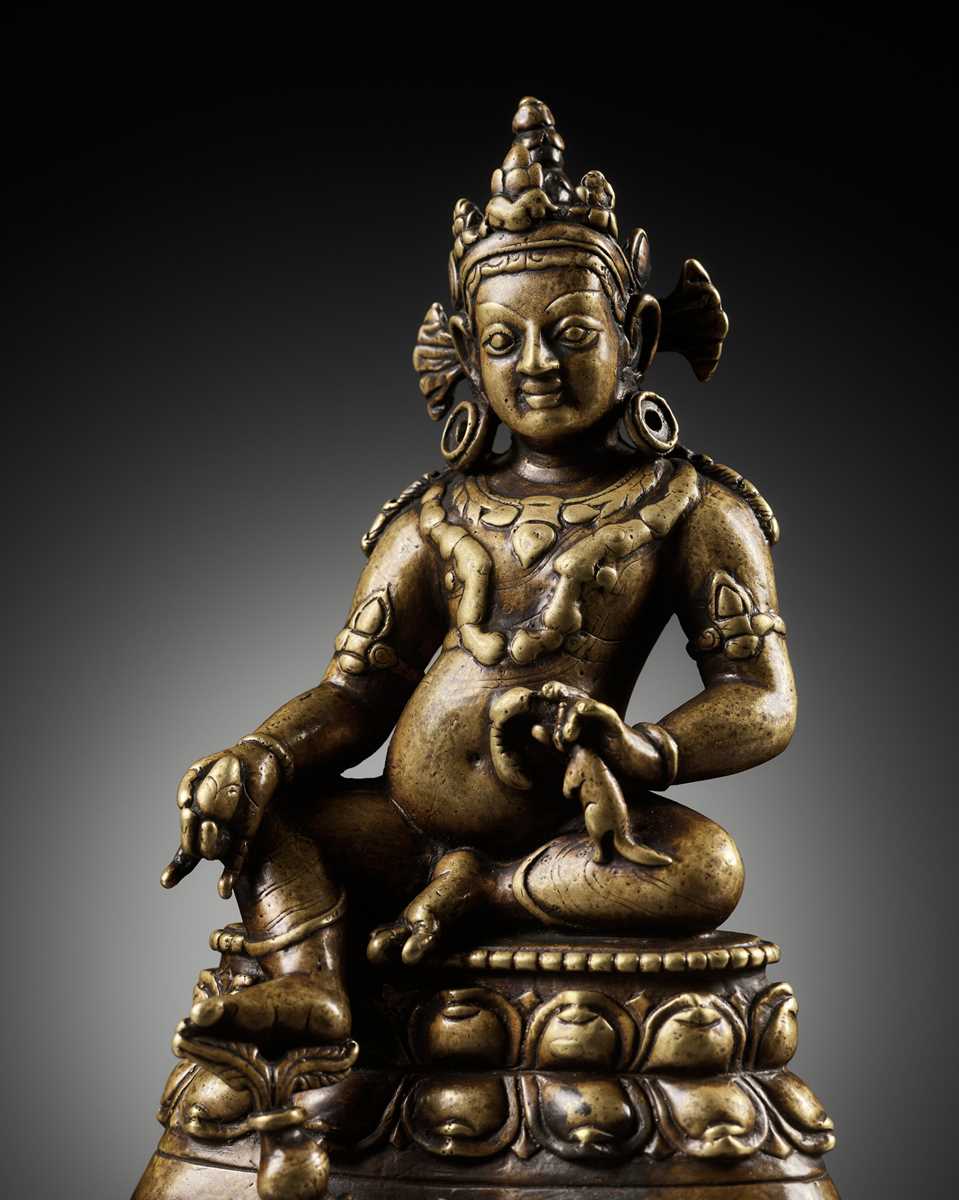11th Apr, 2024 11:00
TWO-DAY AUCTION: Fine Asian Art, Buddhism and Hinduism
15
A BRONZE FIGURE OF JAMBHALA, TIBET, PALA STYLE, 13TH-14TH CENTURY
Sold for €16,900
including Buyer's Premium
Cast seated in lalitasana on a double lotus base with beaded rim, the right foot resting on a vessel issuing leaves, holding mongoose in his left hand and in the right a bijapuraka fruit, rotund belly, wearing fine jewelry and armlets, the face with round eyes, full lips forming a gentle smile, and the head surmounted by a floral tiara and tiered ushnisha. The base sealed and incised with a double vajra.
Provenance: From a German private collection.
Condition: Very good condition with minor wear, few light scratches, tiny nicks, and casting flaws. Fine, smooth, naturally grown patina.
Weight: 598.7 g
Dimensions: Height 16.2 cm
This Tibetan bronze is stylistically informed by the Pala style of Northeastern India, which Tibetan artists drew on to produce their own sculptures. Pala idioms referenced here include the triangular foliate crown leaves, the crown's projecting side ribbons, and double lotus base with a beaded rim. Meanwhile, other aspects betray Tibetan characteristics, such as the base's plump and flattened lotus petals, both frequented throughout early Tibetan bronzes of the 13th and 14th centuries. This combination of stylistic elements exemplifies Tibetan artist's close apprenticeship of Pala art during and shortly after the Second Transmission of Buddhism from India to Tibet, known as the Chidar (late 10th-12th centuries).
Primarily known as the God of Wealth, Jambhala is one of the most popularly worshiped deities in Tibetan Buddhism, propitiated in order to avoid the mundane distractions of ensuring sustenance so that practitioners can focus on their spiritual training. Here, a skilled craftsman has represented the deity in his full, corpulent glory, symbolic of the abundance Jambhala is able to grant. Jambhala offers a bijapuraka fruit with his outstretched right hand, while his left massages the neck of a magical mongoose, prompting it to disgorge three strands of jewels from its plump belly. The deity rests his pendent right foot comfortably on a money pot, while clad in resplendent jewelry indicative of the wealth they store. With these delightful details, the master hand has produced a vision of Jambhala with wide-opened eyes and a faint smile—appearing alert and engaged—a reminder of the deity's imminent presence to the mortal realm.
Literature comparison:
Compare a related copper alloy figure of Jambhala, dated 13th-14th century, 21.6 cm high, formerly in the Nyingjei Lam Collection and sold at Bonhams Hong Kong, 7 October 2019, lot 806. Compare a related bronze figure of Jambhala, late 13th century, 21 cm tall, in the Norton Simon Museum, accession number M.1975.14.06.S. Compare a related bronze figure of Jambhala, 14th century, 14 cm tall, in The British Museum, museum number 1983,1109.1.
Auction result comparison:
Type: Closely related
Auction: Christie’s New York, 25 March 2004, lot 66
Price: USD 14,340 or approx. EUR 21,000 converted and adjusted for inflation at the time of writing
Description: A Bronze Figure of Jambhala, Tibet, circa 13th century
Expert remark: Compare the closely related pose, lotus base, and crown with side ribbons. Note the size (19 cm).
Cast seated in lalitasana on a double lotus base with beaded rim, the right foot resting on a vessel issuing leaves, holding mongoose in his left hand and in the right a bijapuraka fruit, rotund belly, wearing fine jewelry and armlets, the face with round eyes, full lips forming a gentle smile, and the head surmounted by a floral tiara and tiered ushnisha. The base sealed and incised with a double vajra.
Provenance: From a German private collection.
Condition: Very good condition with minor wear, few light scratches, tiny nicks, and casting flaws. Fine, smooth, naturally grown patina.
Weight: 598.7 g
Dimensions: Height 16.2 cm
This Tibetan bronze is stylistically informed by the Pala style of Northeastern India, which Tibetan artists drew on to produce their own sculptures. Pala idioms referenced here include the triangular foliate crown leaves, the crown's projecting side ribbons, and double lotus base with a beaded rim. Meanwhile, other aspects betray Tibetan characteristics, such as the base's plump and flattened lotus petals, both frequented throughout early Tibetan bronzes of the 13th and 14th centuries. This combination of stylistic elements exemplifies Tibetan artist's close apprenticeship of Pala art during and shortly after the Second Transmission of Buddhism from India to Tibet, known as the Chidar (late 10th-12th centuries).
Primarily known as the God of Wealth, Jambhala is one of the most popularly worshiped deities in Tibetan Buddhism, propitiated in order to avoid the mundane distractions of ensuring sustenance so that practitioners can focus on their spiritual training. Here, a skilled craftsman has represented the deity in his full, corpulent glory, symbolic of the abundance Jambhala is able to grant. Jambhala offers a bijapuraka fruit with his outstretched right hand, while his left massages the neck of a magical mongoose, prompting it to disgorge three strands of jewels from its plump belly. The deity rests his pendent right foot comfortably on a money pot, while clad in resplendent jewelry indicative of the wealth they store. With these delightful details, the master hand has produced a vision of Jambhala with wide-opened eyes and a faint smile—appearing alert and engaged—a reminder of the deity's imminent presence to the mortal realm.
Literature comparison:
Compare a related copper alloy figure of Jambhala, dated 13th-14th century, 21.6 cm high, formerly in the Nyingjei Lam Collection and sold at Bonhams Hong Kong, 7 October 2019, lot 806. Compare a related bronze figure of Jambhala, late 13th century, 21 cm tall, in the Norton Simon Museum, accession number M.1975.14.06.S. Compare a related bronze figure of Jambhala, 14th century, 14 cm tall, in The British Museum, museum number 1983,1109.1.
Auction result comparison:
Type: Closely related
Auction: Christie’s New York, 25 March 2004, lot 66
Price: USD 14,340 or approx. EUR 21,000 converted and adjusted for inflation at the time of writing
Description: A Bronze Figure of Jambhala, Tibet, circa 13th century
Expert remark: Compare the closely related pose, lotus base, and crown with side ribbons. Note the size (19 cm).
Zacke Live Online Bidding
Our online bidding platform makes it easier than ever to bid in our auctions! When you bid through our website, you can take advantage of our premium buyer's terms without incurring any additional online bidding surcharges.
To bid live online, you'll need to create an online account. Once your account is created and your identity is verified, you can register to bid in an auction up to 12 hours before the auction begins.
Intended Spend and Bid Limits
When you register to bid in an online auction, you will need to share your intended maximum spending budget for the auction. We will then review your intended spend and set a bid limit for you. Once you have pre-registered for a live online auction, you can see your intended spend and bid limit by going to 'Account Settings' and clicking on 'Live Bidding Registrations'.
Your bid limit will be the maximum amount you can bid during the auction. Your bid limit is for the hammer price and is not affected by the buyer’s premium and VAT. For example, if you have a bid limit of €1,000 and place two winning bids for €300 and €200, then you will only be able to bid €500 for the rest of the auction. If you try to place a bid that is higher than €500, you will not be able to do so.
Online Absentee and Telephone Bids
You can now leave absentee and telephone bids on our website!
Absentee Bidding
Once you've created an account and your identity is verified, you can leave your absentee bid directly on the lot page. We will contact you when your bids have been confirmed.
Telephone Bidding
Once you've created an account and your identity is verified, you can leave telephone bids online. We will contact you when your bids have been confirmed.
Classic Absentee and Telephone Bidding Form
You can still submit absentee and telephone bids by email or fax if you prefer. Simply fill out the Absentee Bidding/Telephone bidding form and return it to us by email at office@zacke.at or by fax at +43 (1) 532 04 52 20. You can download the PDF from our Upcoming Auctions page.
How-To Guides
How to Create Your Personal Zacke Account
How to Register to Bid on Zacke Live
How to Leave Absentee Bids Online
How to Leave Telephone Bids Online
中文版本的操作指南
创建新账号
注册Zacke Live在线直播竞拍(免平台费)
缺席投标和电话投标
Third-Party Bidding
We partner with best-in-class third-party partners to make it easy for you to bid online in the channel of your choice. Please note that if you bid with one of our third-party online partners, then there will be a live bidding surcharge on top of your final purchase price. You can find all of our fees here. Here's a full list of our third-party partners:
- 51 Bid Live
- EpaiLive
- ArtFoxLive
- Invaluable
- LiveAuctioneers
- the-saleroom
- lot-tissimo
- Drouot
Please note that we place different auctions on different platforms. For example, in general, we only place Chinese art auctions on 51 Bid Live.
Bidding in Person
You must register to bid in person and will be assigned a paddle at the auction. Please contact us at office@zacke.at or +43 (1) 532 04 52 for the latest local health and safety guidelines.

